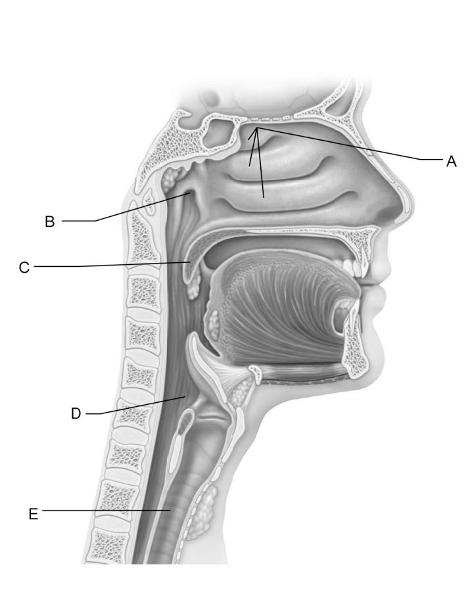
Identify the letter that indicates structures that assist in
filtering, heating, and humidifying
inspired air.
A)
A
B) B
C) C
D) D
E) E
A
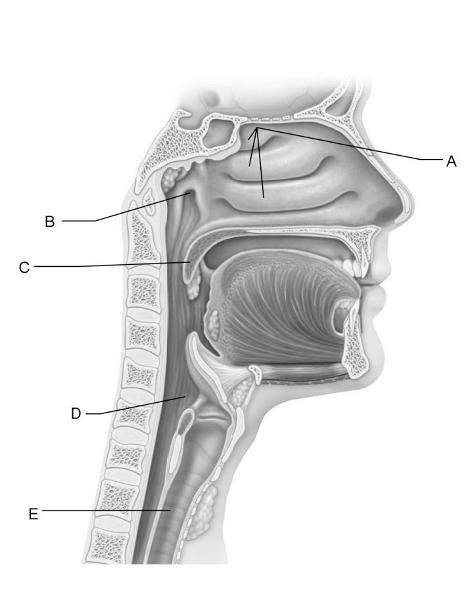
Identify the letter that indicates a muscular tube that serves as a
common passageway for food
and air.
A) A
B) B
C)
C
D) D
E) E
D
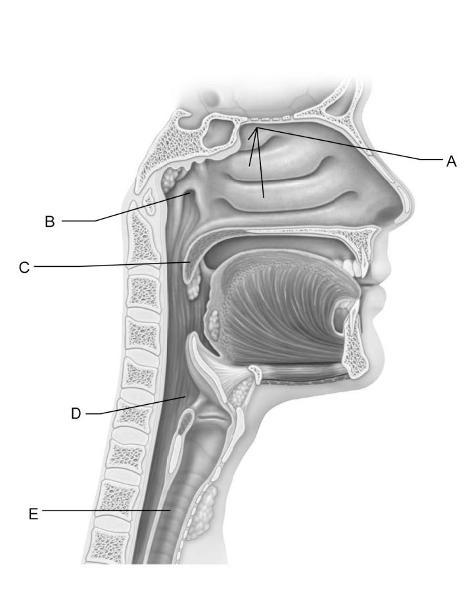
Identify the letter that indicates a flexible tube that has C-shaped
cartilaginous rings that keep
it from collapsing.
A)
A
B) B
C) C
D) D
E) E
E
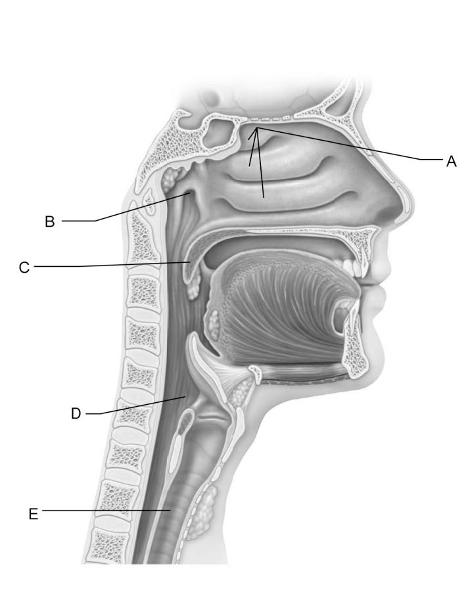
Identify the letter that indicates the opening of the
pharyngotympanic tube.
A) A
B) B
C) C
D) D
E) E
B

Identify the letter that indicates the uvula.
A) A
B)
B
C) C
D) D
E) E
C
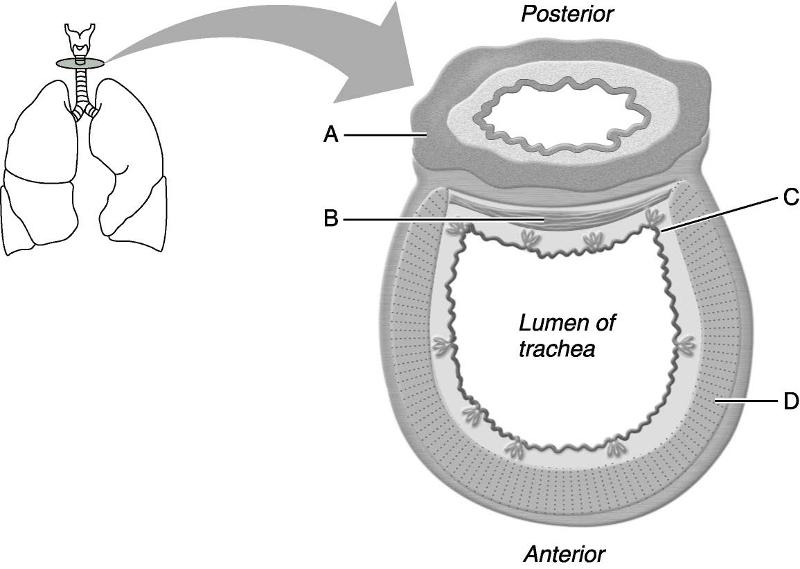
Identify the letter that indicates Ciliated cells in this layer
transport mucus laden with dust,
bacteria, pollen, and viruses
towards the pharynx.
A) A
B) B
C) C
D) D
E) E
C
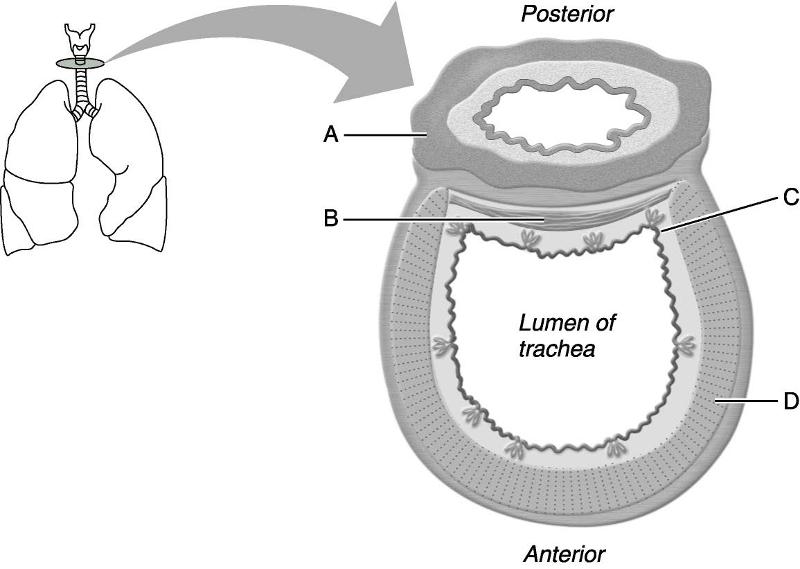
Identify the letter that indicates the fibromusculocartilaginous
layer with hyaline cartilaginous
rings that allow the trachea to
bend and elongate but not collapse.
A) A
B) B
C)
C
D) D
E) E
D
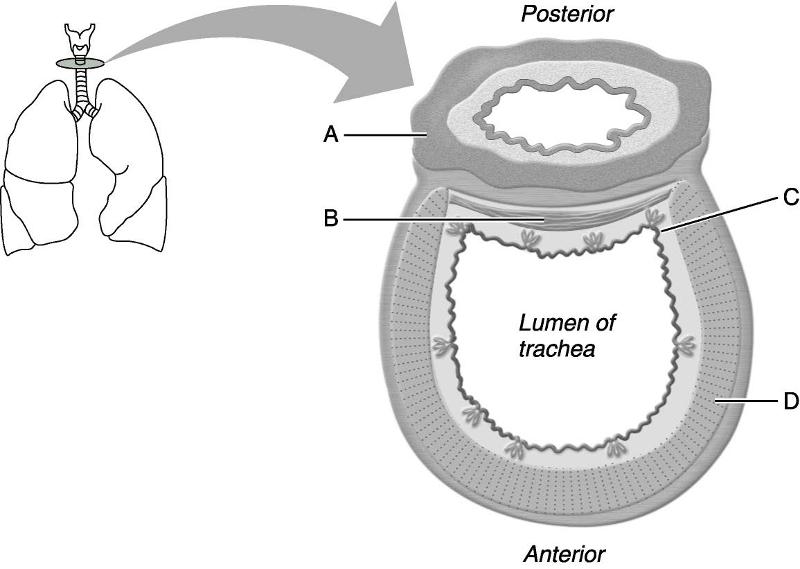
Identify the letter that indicates the trachealis muscle.
A)
A
B) B
C) C
D) D
E) E
B
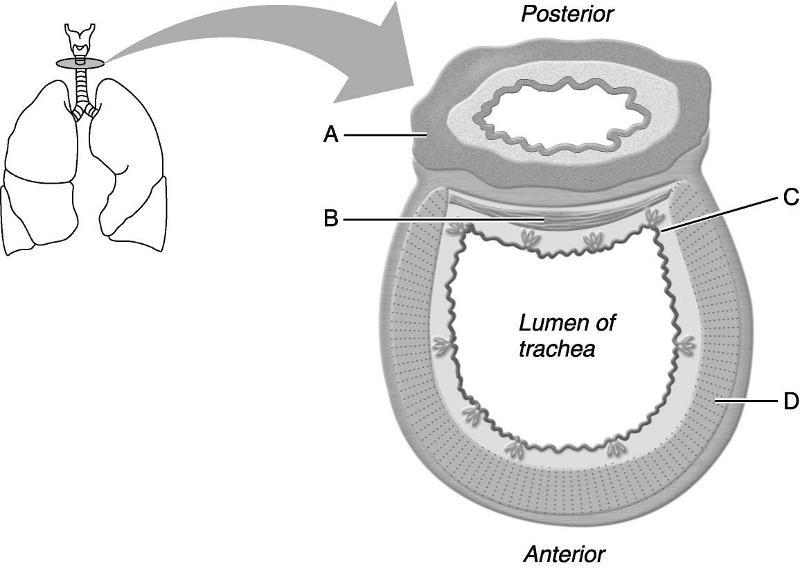
Identify the letter that indicates the soft wall of the trachea
allows the esophagus to expand
anteriorly.
A) A
B)
B
C) C
D) D
E) E
B
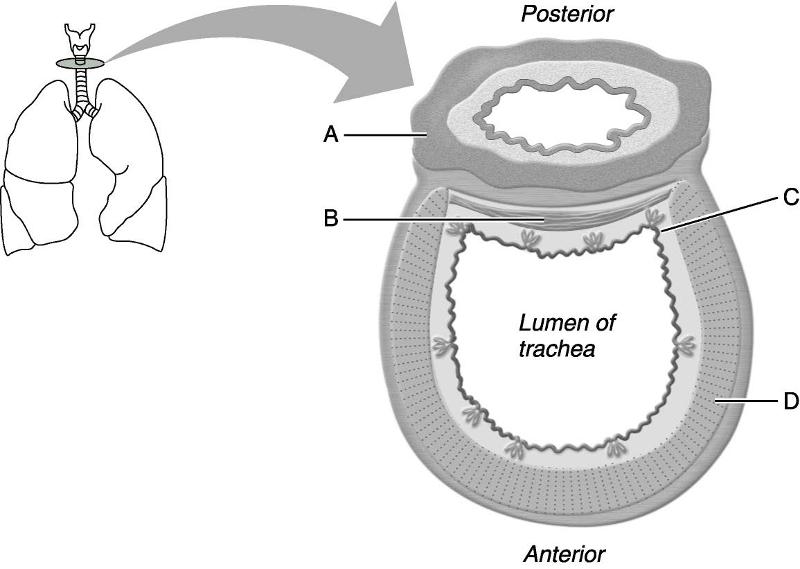
Identify the letter that indicates a muscular tube that propels
swallowed food to the stomach.
A) A
B) B
C) C
D)
D
E) E
A

Identify the letter that indicates the cartilage that has a laryngeal
prominence that is also
known as the "Adam's
apple."
A) A
B) B
C) C
D) D
E) E
D

Identify the letter that indicates the vocal fold, or true vocal
cord.
A) A
B) B
C) C
D) D
E) E
E
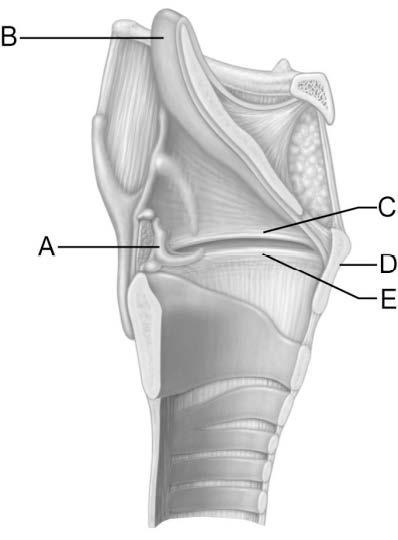
Identify the letter that indicates the cartilage that folds over the
opening of the larynx — the
glottis. The function of this
cartilage is to prevent aspiration of foods and liquids into the
lower
respiratory tubes.
A) A
B) B
C) C
D)
D
E) E
B
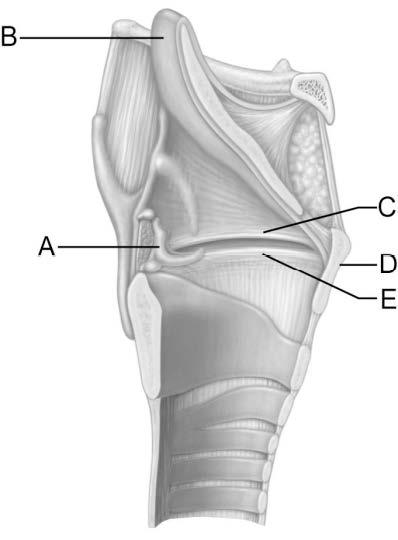
Identify the letter that indicates the vestibular fold, or false
vocal cord.
A) A
B) B
C) C
D) D
E) E
C
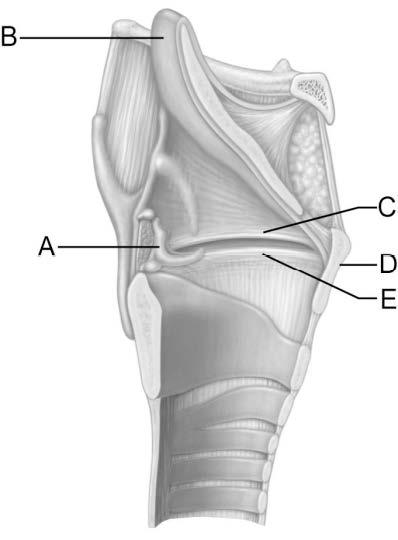
Identify the letter that indicates the cartilage that anchors the
vocal cords posteriorly.
A) A
B) B
C) C
D)
D
E) E
A
Anatomical region of the nasal cavity containing nose hairs.
A)
nasal septum
B) olfactory mucosa
C) nasal conchae
D)
vestibule
E) uvula
D
The smallest airway of the bronchial tree that is primarily
responsible for creating
bronchoconstriction.
A) primary
bronchi
B) bronchiopulmonary segment
C) lobe of lung
D)
bronchiole
E) alveoli sac
D
Alveolar cells that allow rapid diffusion of respiratory
gases.
A) Type I
B) Type II
C) alveolar
macrophages
D) endothelial cells
E) pseudostratiied columnar
epithelial cells
A
The serous membrane lining of the wall of the thoracic
cavity.
A) visceral pleura
B) parietal pleura
C) mucous
membrane
D) parietal pericardium
E) visceral pericardium
B
The region of the lung served by secondary, or lobar,
bronchi.
A) bronchopulmonary segment
B) lobe
C)
lobule
D) lingular
E) cardiac notch
B
Fluid that reduces surface tension of the alveolar walls.
A)
serous fluid
B) pleural fluid
C) surfactant
D)
lysozyme
E) mucin
C
These are peripheral chemoreceptors that monitor changes in
respiratory gasses and blood
acidity levels.
A) ventral
respiratory center
B) vagus nerve
C) reticular activating
system
D) carotid bodies
E) medulla oblongata
D
The medial opening between the vocal folds through which air
passes.
A) glottis
B) vestibule
C) rima
glottidis
D) thyrohyoid membrane
E) cricothyroid ligament
C
Specific location within the lungs where gas exchange occurs.
A)
terminal bronchioles
B) carina
C) bronchopulmonary
segments
D) alveoli
E) respiratory membrane
E
Fissure separating the upper and middle lobes of the right
lung.
A) horizontal
B) oblique
C) carina
D)
superior
E) inferior
A
The superior and middle nasal conchae are bony projections from
the
A) vomer.
B) ethmoid bone.
C) sphenoid
bone.
D) maxillary bone.
B
Which cells produce surfactant?
A) type I cells
B) type II
cells
C) alveolar macrophages
D) chondrocytes
B
Which part of the nose is composed of dense fibrous connective
tissue?
A) the apex
B) the border where the nostril attaches
to the maxilla
C) the nasal septum
D) the surface connecting
to the nasal bones
B
The rubbing together of inflamed pleural membranes that produces a
stabbing pain in the
chest is called
A) influenza.
B)
tuberculosis.
C) rhinitis.
D) pleurisy.
D
Which structure is not located within the nasopharynx?
A)
opening of the pharyngotympanic tube
B) palatine tonsil
C)
pharyngeal tonsil
D) tubal tonsil
B
Which of the following is not a function of the nasal
conchae?
A) They deflect particulates to the mucosa.
B) They
help warm the air.
C) They decrease the turbulence in the flow of
air through the nasal cavity.
D) They moisten the air.
C
When the diaphragm contracts, the size of the thoracic cavity
________, the pressure inside
the thoracic cavity ________, and
air flows ________ the lungs.
A) decreases; rises; into
B)
increases; drops; into
C) decreases; drops; out of
D)
increases; drops; out of
B
In lung cancer, the cancer cells usually arise from
A) the
smooth muscle fibers around the bronchioles.
B) the epithelium
lining a large bronchus.
C) the alveoli.
D) lymph nodes in
the lung.
B
Vibrissae are
A) specialized cells in the larynx that react to
vibrations of air.
B) large hairlike projections on epithelial
cells that line the trachea.
C) nose hairs.
D) the sensory
organs of the inner ear.
C
Which muscle contracts during forced expiration?
A) internal
oblique
B) serratus anterior
C) sternocleidomastoid
D)
pectoralis major
A
The part of the brain that generates the basic respiratory rhythm is
the
A) medulla oblongata.
B) limbic system.
C)
hypothalamus.
D) cerebrum.
A
Sympathetic stimulation of terminal bronchioles causes
A)
bronchoconstriction.
B) a decrease in blood supply to the
bronchioles.
C) bronchodilation.
D) secretion of less surfactant.
C
The left lung
A) has three lobes.
B) is supplied entirely
by a secondary bronchus.
C) receives oxygenated blood from the
heart via the left pulmonary artery.
D) has a cardiac notch.
D
Which portion of the nasal cavity is lined with sebaceous and sweat
glands and numerous
hair follicles?
A) hard and soft
palate
B) nasal conchae
C) roof (ceiling)
D) vestibule
D
The detergent-like molecule that keeps the alveoli from collapsing
between breaths is called
A) bile.
B) hemoglobin.
C)
surfactant.
D) oxygen.
C
The passageway between the nasopharynx and the middle ear is
the
A) oval window.
B) internal acoustic meatus.
C)
mastoid sinus.
D) pharyngotympanic tube.
D
Of the three different layers of tissue in the wall of the trachea,
the outermost layer is the
A) adventitia.
B) lamina
propria.
C) submucosa.
D) muscularis.
A
What type of epithelium occurs in the respiratory mucosa?
A)
pseudostratified ciliated columnar epithelium
B) simple squamous
epithelium
C) simple columnar epithelium
D) stratified
squamous epithelium
A
Some bronchi have names such as the "right upper-lobe
bronchus," "left lower-lobe
bronchus," and
"right middle-lobe bronchus." These are ________
bronchi.
A) primary
B) secondary
C) tertiary
D)
very small (about fifteenth-order)
B
The correct definition of bronchopulmonary segments is
A)
arbitrary subdivisions of a lung, about as large as a fist (0.3
liter).
B) parts of the lung that are easy to remove during
surgery.
C) parts of the lungs that are separated by the oblique
and horizontal fissures.
D) parts of the lung that are supplied
by a single tertiary bronchus (and its branches).
D
The ________ flaps over the glottis when we swallow food.
A)
uvula
B) epiglottis
C) palate
D) vocal fold
B
The respiratory mucosa is present throughout each of the following
areas except the
A) bronchi.
B) nasal cavity.
C)
nasopharynx.
D) superior laryngopharynx.
D
Most foreign substances in inspired air fail to reach the lungs
because of the
A) ciliated epithelium and mucus that line the
respiratory passages.
B) abundant blood supply to the nasal
mucosa.
C) porous structure of the nasal conchae.
D) action
of the epiglottis.
A
The ability to vary the pitch of the voice results from
varying
A) the force of air passing over the vocal folds.
B)
the tension in the vocal folds.
C) the size of the laryngeal
cartilages.
D) the shape of the cricoid cartilage.
B
In the wall of the trachea and bronchi, the cartilage rings lie
within which tissue layer?
A) inner epithelium
B)
mucosa
C) submucosa
D) fibromusculocartilaginous layer
D
The aortic bodies
A) sense the concentration of oxygen and
carbon dioxide in the blood.
B) give rise to the pulmonary
arteries.
C) are innervated by the glossopharyngeal
nerve.
D) are in the hilum of the lung.
A
Of the following, which is the only organ that is not an upper
respiratory structure? (Hint:
Recall Figure 22.3.)
A)
larynx
B) oropharynx
C) vestibule of the nose
D) nasal cavity
A
An aortic aneurysm that presses on the left recurrent laryngeal nerve
could lead to
A) paralysis of the diaphragm.
B) hoarse
speech.
C) complete loss of speech.
D) inability of the
carotid sinus to monitor blood gases.
B
The main function of the elaborate venous plexus in the nasal mucosa
is
A) diapedesis of leukocytes.
B) to replace vessels broken
in nose bleeds.
C) to supply extra blood to the brain and
supplement the dural sinuses.
D) to warm blood and moisten
inhaled air.
D
The vocal ligaments attach between the thyroid cartilage and
the
A) arytenoid cartilage.
B) corniculate
cartilage.
C) cricoid cartilage.
D) cuneiform cartilage.
A
The trachealis muscle
A) constricts the trachea.
B)
controls the length and tension of the vocal cords.
C) initiates
the cough reflex.
D) raises the larynx when swallowing.
A
The pharyngeal tonsil is
A) scattered throughout the
pharynx.
B) in the fauces.
C) the largest tonsil.
D)
synonymous with the adenoids in the roof of the nasopharynx.
D
Embryologically, the nasal cavity develops from
A) invagination
of the ectoderm of the olfactory placode.
B) the
nasopharynx.
C) a cranial extension of the mouth.
D) the
early precursor of the paranasal sinuses.
A
Supportive cartilage disappears from the bronchial tree at the level
of the
A) alveolar duct.
B) bronchioles.
C) lobar
bronchi.
D) respiratory bronchiole.
B
The lobes of a lung are easy to recognize and distinguish from one
another because
A) they all have slightly different
colors.
B) they are separated by fissures.
C) each is
supplied by a primary bronchus, and the primary bronchi are easy to
find.
D) carbon from the air accumulates between and outlines the
lobes in most people (even if they
breathe almost-unpolluted air).
B
Alveolar pores
A) allow gases to transfer from the alveoli to
the blood.
B) allow pleural fluid to enter the alveoli and keep
their walls from sticking together.
C) are the openings between
the alveolar duct and the alveolus.
D) equalize air pressure
throughout the lung.
D
The space between the right and left vocal folds is called
the
A) laryngeal inlet.
B) cricoid.
C)
vestibule.
D) rima glottidis.
D
Which structure does not enter or exit from the hilum of a
lung?
A) bronchial vein
B) phrenic nerve
C) pulmonary
artery
D) pulmonary plexus
B
Which structure is both a lower respiratory structure and in the
conducting zone? (Hint:
Recall Figure 22.3.)
A) the
laryngopharynx
B) a respiratory bronchiole
C) any
bronchus
D) an alveolus
C
In a runner who is breathing heavily during a race, the rima
glottidis is
A) half closed.
B) half open.
C) open as
far as possible.
D) all the way closed.
C
It is easy to see on the outer surface of a smoker's lung hexagons
approximately the size of
the tip of a little finger and clearly
outlined by black lines of carbon. These structures are
A)
lobes.
B) bronchopulmonary segments.
C) lobules.
D) bronchioles.
C
Which muscle is used for both quiet inspiration and forced
expiration?
A) external intercostals
B) internal
intercostals
C) latissimus dorsi
D) scalenes
B
Which of the following changes does not occur as the conducting tubes
of the respiratory tree
become smaller?
A) Cartilage rings
are replaced by irregular plates of cartilage.
B) The lining
epithelium thins.
C) Elastin in the walls disappears.
D)
Cartilage disappears in the bronchioles.
C
The ventral respiratory group (VRG) is a group of neurons located
within the
A) forebrain.
B) medulla oblongata.
C)
midbrain.
D) pons.
B
In a preserved cadaver, the first rib is likely to form a groove on
which surface of the lung?
A) basal
B) mediastinal
C)
inferior costal
D) apical (apex)
D
The lungs are located in the
A) mediastinum.
B)
abdominopelvic cavity.
C) thoracic cavity.
D) pleura.
C
The trachea, bronchi, and bronchioles are all located within the lungs.
A) True
B) False
B
Changes in the size of the thoracic cavity bring about inspiration and expiration.
A) True
B) False
A
Type II alveolar cells produce pleural fluid to keep the walls of the
alveoli from collapsing or
adhering together.
A) True
B) False
B
Gas exchange occurs across the bronchi and bronchioles.
A) True
B) False
B
The left lung has both a horizontal fissure and oblique fissure.
A) True
B) False
B
The pleural cavities extend two ribs below the inferior border of the lungs.
A) True
B) False
A
The external intercostal muscles are involved in active inspiration.
A) True
B) False
A
The groove through which air passes between nasal conchae is called a choanae.
A) True
B) False
B
The respiratory zone begins at the large bronchioles.
A) True
B) False
B
The only laryngeal cartilage to form a complete ring is the cuneiform.
A) True
B) False
B
When the diaphragm contracts, it raises the floor of the thoracic cavity upward.
A) True
B) False
B
The scalene muscles are involved in deep inspiration.
A) True
B) False
A
The number of secondary, or lobar, bronchi is a distinguishing
characteristic of the right and
left lungs.
A) True
B) False
A
The vocal ligaments are attached between the cricoid and arytenoid cartilages.
A) True
B) False
B
The mucosal epithelium transitions from pseudostratified columnar to
simple cuboidal along
the path to the respiratory bronchioles.
A) True
B) False
A